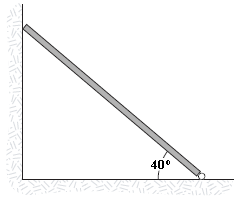The planet Neptune is:
A) easily visible with the naked eye.
B) barely visible with the naked eye.
C) visible with at least small telescopes or binoculars.
D) only visible with a large, high-quality telescope.
E) only visible with a space-based telescope.
C
You might also like to view...
Complete the equation:

A uniform beam having a mass of 60 kg and a length of 2.8 m is held in place at its lower end by a pin. Its upper end leans against a vertical frictionless wall as shown in the figure. What is the magnitude of the force the pin exerts on the beam?
A. 0.68 kN B. 0.57 kN C. 0.74 kN D. 0.63 kN E. 0.35 kN
Stellar paralax proves that Earth is
a. rotating. b. revolving. c. precessing. d. an oblate spheroid.
Why are methods to determine the distances to galaxies termed the "distance ladder"? Explain the term with examples
What will be an ideal response?